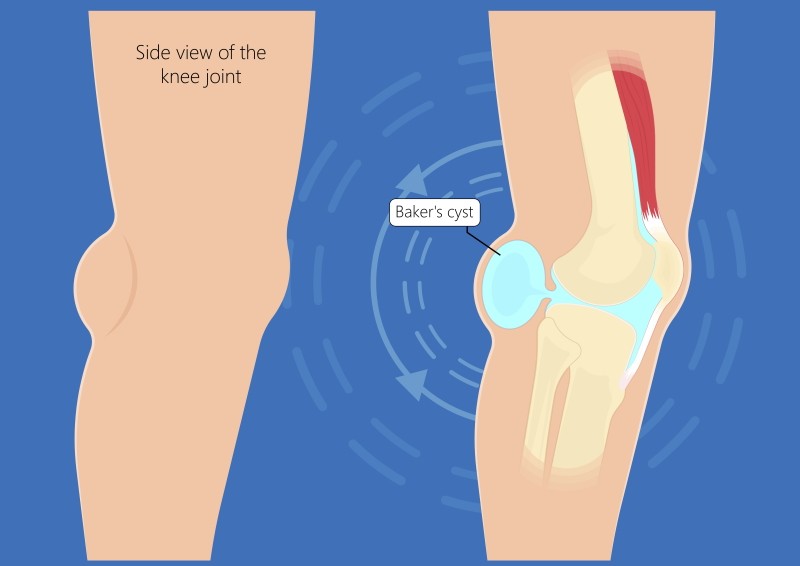
Causes of Pain Behind the Knee
Pain behind the knee can be caused by several factors, including Baker’s cyst, arthritis, infection, injury, tumor, or deep vein thrombosis.
The knee, being the largest and most complex joint in the body, is prone to pain. While knee pain is common, pain behind the knee is less frequent.
Pain in the back of the knee, known as posterior knee pain, can have various causes. Sometimes, the pain is referred from the front of the knee or the spine.
Contents
Symptoms of Pain Behind the Knee
The symptoms of pain behind the knee can vary depending on the underlying condition. Common symptoms include:
Varying Types of Pain
The pain can be sharp, dull, or burning. It may appear suddenly or gradually. It may be continuous or occur when weight is put on the leg or when the knee is bent. These details can help doctors diagnose the knee problem.
Swelling or Stiffness
Swelling or misshapen appearance of the knee, as well as difficulty bending the knee or experiencing knee pops, instability, or collapse while weight bearing, suggests an injury or another possible cause.
Redness or Warmth
In certain cases, the back of the knee may feel hot to the touch or show visible signs of redness. Fever may also be present. These symptoms indicate a different cause compared to just experiencing pain.
Causes of Pain Behind the Knee
The causes of pain behind the knee can be simple or more challenging to diagnose. Some common causes include:
Baker’s Cyst
Baker’s cyst, characterized by a lump-like swelling behind the knee, is relatively easy to diagnose. It forms when fluid collects at the back of the knee due to injury or arthritis-related stress.
Arthritis
Arthritis, a joint disease, can cause pain in any part of the knee joint, including the back. Osteoarthritis, associated with aging or overuse, is the most common type of knee pain. Rheumatoid arthritis affects both knees simultaneously. Gout and septic arthritis are other forms of arthritis that may affect the knees.
Infection
The knee can be affected by various infections, including skin infection (cellulitis), bone infection (osteomyelitis), or infection of the fluid-filled sacs called bursae (septic bursitis). Pain, redness, heat, and swelling are common symptoms of infections.
Injury
Pain behind the knee can also result from muscle, tendon, ligament, or other connective tissue damage, which can be acute or caused by overuse. Hamstring injuries, meniscus tears, and posterior cruciate ligament (PCL) injuries are examples of injuries that can cause back-of-the-knee pain.
Tumor
Tumors are rarely responsible for knee pain, but both benign and malignant tumors can occur near the knee. Liposarcoma, osteosarcoma, and synovial sarcoma are three types of cancer that can cause pain behind the knee.
Deep Vein Thrombosis
Deep vein thrombosis (DVT) occurs when a blood clot forms deep within a vein. While typically found in the pelvis, thigh, or calf, DVT can cause pain anywhere in the leg, including the back of the knee. DVT is a serious condition that can lead to life-threatening complications.
When to See a Doctor for Pain Behind the Knee
Most cases of pain behind the knee warrant a visit to the doctor. Immediate medical attention is required if there are signs of infection or DVT, or if the pain is severe. Even for less urgent symptoms, consulting with a doctor is recommended to guide recovery. In the meantime, over-the-counter pain medications like ibuprofen can temporarily manage pain. For knee injuries, the RICE protocol (rest, ice, compress, and elevate) can be used.
Diagnosis and Treatment for Pain Behind the Knee
In diagnosing posterior knee pain due to injury or arthritis, a physical examination is crucial. The doctor assesses leg manipulation, rotation, flexion, and stability to identify movements causing pain.
Imaging procedures like ultrasound, X-ray, CT, arthrography, and MRI may be used by the doctor. In some cases, the doctor may extract fluid from the knee for laboratory examination.
If an infection, tumor, or DVT is suspected, the doctor will employ physical examination, lab studies, and imaging. Certain diagnoses, like Baker’s cyst, can sometimes be confirmed through a visual examination.
Treatment for pain behind the knee depends on the underlying cause. Rest, medication, physical therapy, injections, or surgery may be recommended for injuries, wear and tear, or arthritis. Some Baker’s cysts resolve on their own, while others may require drainage. Infections, tumors, and DVT demand personalized treatment based on the diagnosis.
Common Knee Injuries
Knee injuries can happen to anyone, but certain activities and demographics face a higher risk. Athletes involved in high-impact sports, runners wearing inadequate footwear, individuals who are overweight, and those who sit in uncomfortable positions for prolonged periods are at higher risk. Untreated knee injuries can lead to complications like ligament instability, meniscus injury, osteoarthritis, and gait problems. Recognizing signs of a serious knee injury is crucial for seeking prompt treatment from a healthcare professional.
Signs of a Knee Injury
Pain is often the first noticeable sign of a knee injury. Mild stiffness or discomfort around the knee joint, especially during specific repetitive movements, may accompany the pain. Other important warning signs include:
Pain While Climbing Stairs
Pain while climbing up the stairs suggests a torn meniscus, while pain while going down the stairs indicates the kneecap painfully pushing against the femur bone in the leg.
Swelling
Swelling may prevent weight-bearing or bending of the knee, although walking may not be an issue in some cases. A swollen knee should not be ignored.
Immediate Pain
Immediate pain and swelling, occurring suddenly during exercise, may indicate a torn ligament or bone fracture.
Gradual Pain
Some injuries manifest several hours or days after the initial trauma. Overuse injuries, which develop gradually due to extended pressure, can suggest cartilage or meniscus tearing.
Other signs to watch for include redness, bruising, popping sounds, and feeling of instability. If any of these symptoms occur, medical attention should be sought.
Types of Knee Injuries
While some knee pain subsides with rest, certain injuries are more severe. The most common types of knee injuries include:
Stress Fractures
Fractures can affect any bone in the knee joint, resulting from either trauma or osteoporosis.
Dislocation
The knee joint bones can partially or completely fall out of alignment, especially in individuals with bone structure predisposing them to such injuries. Trauma is a common cause of knee dislocation.
Anterior Cruciate Ligament (ACL) Injury
Athletes frequently involved in rapid direction changes or jumping may experience ACL injuries. An audible "pop" may accompany the tearing or straining of the ligament.
Meniscal Tearing
The menisci, cartilages protecting the joint during walking, are often injured during sports activities but can also wear down from aging or arthritis.
Tendonitis
Tendonitis, also known as "jumper’s knee," commonly affects athletes who frequently jump. The quadriceps and patellar tendons, both involved in the knee joint, may be stretched, torn, or degenerated over time.
Diagnosis and Treatments for Knee Injuries
Doctors use various tools to diagnose knee injuries, including collecting medical history, evaluating activity levels, and performing X-rays, ultrasounds, and MRI scans to get a clear view of the knee joint. Mild knee injuries may be treated using the R.I.C.E. method (rest, ice, compression, elevation). Physical therapy may be necessary for other cases, aiming to strengthen the joint and restore range of motion. Serious knee injuries often require surgery, either minimally invasive or involving total joint replacement.
By clicking Submit, I agree to the MedicineNet’s Terms & Conditions & Privacy Policy and understand that I may opt out of MedicineNet’s subscriptions at any time.
Sources:
– American Cancer Society: "What Is a Soft Tissue Sarcoma?"
– Arthritis Foundation: "When Knee Pain May Mean Arthritis."
– Bupa: "Pain behind the knee (posterior knee pain)."
– CDC: "Cellulitis: All You Need to Know."
– CDC: "Venous thromboembolism."
– Current Reviews in Musculoskeletal Medicine: "Posterior knee pain."
– Johns Hopkins: "Liposarcoma."
– Johns Hopkins: "Osteosarcoma."
– Mount Sinai: "Baker cyst."
– NYU Langone Health: "Types of Bone and Joint Infections."
– Stanford Health Care: "Septic Bursitis."


